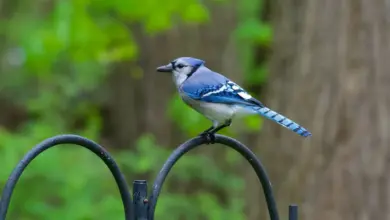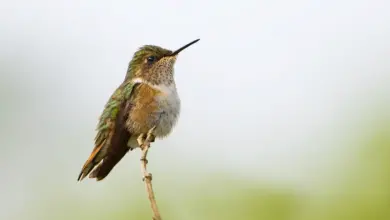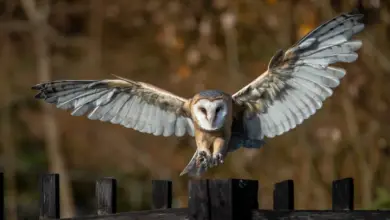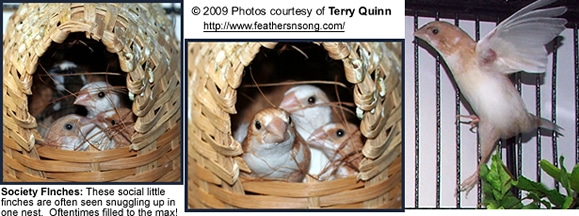Steely-vented Hummingbird
The Steely-vented Hummingbird (Amazilia saucerrottei) is a medium-sized hummingbird with two distinct populations – one found in Central America and the other in South America.
There are some variances in vocalizations and behavior which may warrant reconsideration of one of the Central American subspecies as a separate species – the Blue-vented Hummingbird (A. hoffmanni, syn. A. sophiae).
Alternate (Global) Names
Chinese: ???? … Czech: Kolibrík ocelový, kolib?ík Saucerott?v … Danish: Stålgrøn Amazilie … Dutch: Blauwbuikamazilia … Finnish: Terästimanttikolibri … French: Ariane de Sophie …German: Stahlamazilie, Stahl-Amazilie, Stahlgrüne Amazilie …Italian: Amazilia coda d’acciaio, Colibrì di Saucerotte … Japanese: buronzuemerarudohachidori, ????????????? … Spanish: Amazilia coliazul, Amazilia Culiazul, Amazilia Rabiazul, Amazilia Verde Azul, Amazilia verde-azul, Amazilia Verdiazul …Norwegian: Stålbukkolibri … Polish: szmaragdzik plantacjowy … Russian: ????? ???????? … Slovak: kolibrík plantážový … Swedish: Stålbukskolibri
Distribution / Range
The Central American group occurs naturally in Belize, Costa Rica, El Salvador, Guatemala, Honduras, Mexico, western Nicaragua and Panama.
The South American group is found in Argentina, Bolivia, Chile, Colombia, Ecuador, Peru and northwestern Venezuela.
They are common in open woodland, such as second growth, coffee plantations, gardens, savanna, and the edges and gaps of evergreen forests – especially during the dry season. They occur from sea level to mountain slopes to about 1800 m (5,904 ft) (Stiles and Skutch, 1989).


Subspecies and Distribution
-
- Steel-vented Hummingbird(Amazilia saucerrottei saucerrottei – DeLattre and Bourcier, 1846) – Nominate Race
- Range: Northwestern, north-central and western Colombia
- Blue-vented Hummingbird (Amazilia saucerrottei hoffmanni or A. hoffmanni, syn. A. sophiae – Cabanis and Heine, 1860)
- Range: Western Nicaragua and west and central Costa Rica.
- Range: Northern Colombia and extreme northwestern Venezuela.
- Range: Western Venezuela (Andes of Mérida and Trujillo).
- Steel-vented Hummingbird(Amazilia saucerrottei saucerrottei – DeLattre and Bourcier, 1846) – Nominate Race
Calls / Vocalizations
Its call has been described as a rapid series of descending chit notes in South America, but the Blue-vented’s from Central America as a high sharp tsip. The male’s song is a buzzy squeaky bzz WEEP wup.
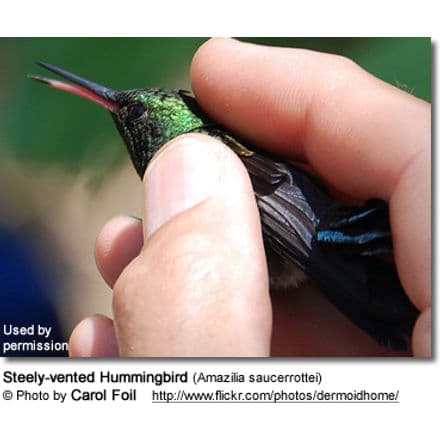
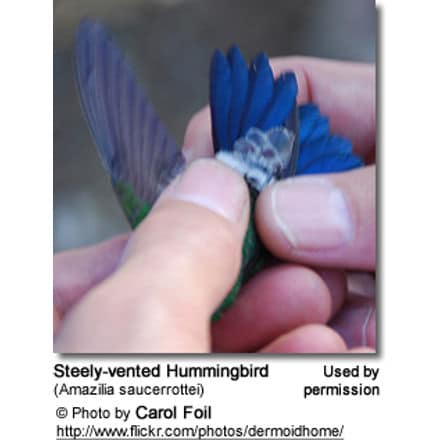
Description
The Steely-vented Hummingbird averages 9 cm or 3.5 inches in length (from top of the head to tip of tail) and weighs about 4.50 g (average) (0.16 oz). The beak is about 0.7″ or 18 mm long. The upper beak is black and the lower bill is pinkish with a dusky tip. The feet are black.
The plumage is mostly bronze-green above turning bronze on the wings, lower back and rump. In full sunlight, the beautiful iridescence and varying shades of the plumage is particularly striking.
The under-tail feathers (crissum) are edged with grey and the outer flight feathers (rectrices) have purplish tips.
The notched tail and the wings are dark, iridescent steel blue-black.
The male’s plumage is mostly iridescent green with a glossygreen throat patch (gorget). The back is greenish bronze to reddish bronze. The under plumage is a dark glittering green, with white thigh-tufts and a blue vent.
The female is duller green below and has grey-buff edges to the vent feathers. Young birds are dull dark bronze-green below. The female’s lower breast and belly is a duller green.
The immature’s underside is a dull, dark bronze-green (Stiles and Skutch, 1989)
Similar Species:
- The Copper-rumped Hummingbird has brownish to rufous –colored under-tail feathers. The rump and upper tail feathers are usually (but not always) more brownish to coppery-colored. The ranges of these two species for the most part don’t overlap, so identification is usually not an issue.
- The Blue-tailed Hummingbirds – which are only accidental visitors to Costa Rica – can be identified by the rufous coloration in the secondary feathers of their wings.
- The Blue-tailed Emerald. is smaller.
- Also similar to the White-chinned Sapphire, Shining-green and Green-bellied Hummingbirds.
Behavior
Both males and females are aggressive and often territorial at their favorite feeding flowers (Stiles and Skutch, 1989). The males are often observed singing from perches that overlook their feeding territory.
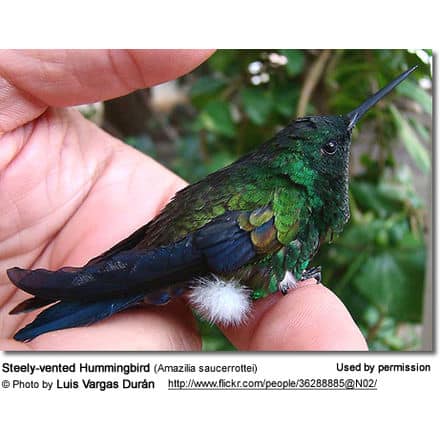
Nesting / Breeding
Hummingbirds are solitary in all aspects of life other than breeding; and the male’s only involvement in the reproductive process is the actual mating with the female. They neither live nor migrate in flocks; and there is no pair bond for this species. Males court females by flying in a u-shaped pattern in front of them. He will separate from the female immediately after copulation. One male may mate with several females. In all likelihood, the female will also mate with several males. The males do not participate in choosing the nest location, building the nest or raising the chicks.
The female is responsible for building the cup-shaped nest out of plant fibers woven together and green moss on the outside for camouflage in a protected location in a shrub, bush or tree about 2 – 7 m (6.5 – 23 feet) above the ground. She lines the nest with soft plant fibers, animal hair and feather down, and strengthens the structure with spider webbing and other sticky material, giving it an elastic quality to allow it to stretch to double its size as the chicks grow and need more room. The nest is typically found on a low, thin horizontal branch.
The average clutch consists of two white eggs, which she incubates alone, while the male defends his territory and the flowers he feeds on. The young are born blind, immobile and without any down.
The female alone protects and feeds the chicks with regurgitated food (mostly partially-digested insects since nectar is an insufficient source of protein for the growing chicks). The female pushes the food down the chicks’ throats with her long bill directly into their stomachs.
As is the case with other hummingbird species, the chicks are brooded only the first week or two, and left alone even on cooler nights after about 12 days – probably due to the small nest size. The chicks leave the nest when they are about 20 days old.
Diet / Feeding
These birds primarily feed on nectar taken from a variety of brightly colored, scented small flowers of vines, trees (Inga, Pithecellobium, Tabebuia, Genipa), shrubs (Hamelia, Stachytarpheta), epiphytes and herbs (Lobelia). They favor flowers with the highest sugar content (often red-colored and tubular-shaped) and seek out, and aggressively protect, those areas containing flowers with high energy nectar. They use their long, extendible, straw-like tongues to retrieve the nectar while hovering with their tails cocked upward as they are licking at the nectar up to 13 times per second. Sometimes they may be seen hanging on the flower while feeding.
Many native and cultivated plants on whose flowers they feed heavily rely on them for pollination. The mostly tubular-shaped flowers actually exclude most bees and butterflies from feeding on them and, subsequently, from pollinating the plants.
In winter, when flowering plants may not be readily available, these nectar-feeding birds may visit local hummingbird feeders to take advantage of some sugar water. They may also drink out of bird baths or water fountains where they will either hover and sip water as it runs over the edge; or these tiny birds will perch on the edge and drink – like all the other birds; but, they usually only remain still for a short moment.
Steely-vented Hummingbirds also feed on small spiders and insects, which are important sources of protein particularly needed during the breeding season to ensure the proper development of their chicks. These insects are often caught in flight (hawking); snatched off leaves or branches, or are taken from spider webs. A nesting female can capture up to 2,000 insects a day.
Males establish feeding territories, where they aggressively chase away other males as well as large insects – such as bumblebees and hawk moths – that want to feed in their territory. Females are equally aggressive at flowers (Stiles and Skutch, 1989).
Hummingbird Resources
- Hummingbird Information
- Hummingbird Amazing Facts
- Attracting Hummingbirds to Your Garden
- Hummingbird Species
- Feeding Hummingbirds

